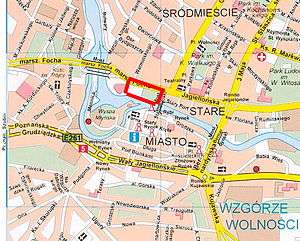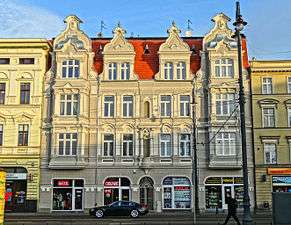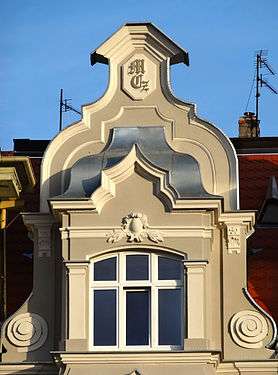Theatre square in Bydgoszcz
| <span class="nickname" ">Polish: Plac Teatralny w Bydgoszczy | |
|
View from Brda river | |
|
Location in Bydgoszcz | |
| Type | Square |
|---|---|
| Owner | City of Bydgoszcz |
| Location | Dowtown Bydgoszcz |
Coordinates: 53°12′40″N 18°00′16″E / 53.21111°N 18.00444°E
| Wikimedia Commons has media related to Theatre square in Bydgoszcz. |
Location
Theatre Square is located in the heart of Bydgoszcz: it is delimitated by the following streets:
- Karmelicka, to the West,
- Ferdinand Foch to the North,
- Mostowa to the East
and Brda river to the South.
It is situated on the northern edge of Bydgoszcz Old Town, and acts as linkage with Bydgoszcz Downtown district, located to north of the river. On the eastern frontage of the square are located urban houses built between the late 19th centuries and the beginning of the 20th century.
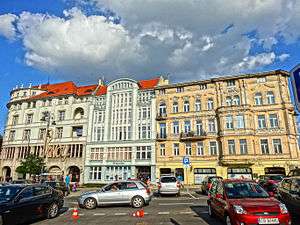
History
The first buildings in the area of the current Theatre Square appeared at the end of the 14th century: it was St. Mary's Church of the Carmelites and their monastic buildings.

In the middle of the 16th century, both the monastery and church have been rebuilt using bricks, the convent was surrounded by a wall part of the defense system of the city. The road leading to the Baltic harbour of Gdansk was controlled by the now gone "Gate of Dantzig" (north of the actual square). Secularization ordered in 1816 by Prussian authorities reshuffled this layout.
In 1822 the church of the Carmelites was razed, and on the place was built the first theatre building. Since then, the area has always borne the actual name, Theatre Square ("Plac Teatralny").
The building had a chaotic life: destroyed by a fire in 1835, it has been rebuilt and burned again in 1890. In 1895, finally, has been erected the Municipal Theatre, designed by Berlin architect Heinrich Seeling. During this construction, the last relic of the Carmelite monastery -a Gothic tower- has been demolished.

In 1888 the square witnessed the first horsecar: 2 lines joined there. In 1896, a railway network was established to run powered trams. In the beginning of 1901, a 3rd line was added: the Square became the largest interchange in Bydgoszcz. On the eve of World War II, four tram lines were running through the place on daily basis. It lost its importance in 1953 when a new interchange in the district of Babia Wieś was set up. Rail tracks from the north-south lines have been liquidated in 1974, since then, trams run through the square on an east-west axis, along its northern frontage (Ferdinand Foch Street).
In the garden along the banks of the Brda river was a popular café called "Theatre" ((Polish) "Teatralną"). In a nearby square, on 18 October 1910, has been unveiled the sculpture The Archer ((Polish) Łuczniczka) by Berliner Ferdinand Lepcke, considered as one of the symbols of Bydgoszcz. After World War II, the masterpiece has been moved to a public garden nearby Gdanska street.
The reconstruction of the Municipal Theatre has been an opportunity of a modernization of the square. The eastern frontage was rebuilt in 1893-1912, with Neo-Baroque and Modern houses, and a partial modernization also was performed along facades onto Mostowa Street and Focha.
During interwar period, Theatre Square was one of the most important and most prominent in Bromberg, and it would be displayed on many postcards and in works of local artists. In 1937-1938, the square underwent another renovation.
In 1945, during the battle for the liberation of the city, the Municipal Theatre has been was hit by shells its interiors burned down.[1] Municipal authorities, mistakenly associating the Theatre with German culture, had it demolished. Since then, Theatre Square lacks the building from which it derives its name.
Eventually, after demolition, the area has been planted with grass and in 1959-1961 the square was extended and it took its current shape, moving out The Archer sculpture further north in Gdanska Street.
Denomination
The square had the following names:[2]
- 1872-1920- Theater-Platz
- 1920-1939- Theater Square
- 1939-1945- Theater-Platz
- 1945-1949- Theater Square
- 1950-1956- Plac Wyzwolenia (Liberation Square)
- 1956-1990- Plac Zjednoczenia (Unity Square)
- 1990- Theatre Square
Current status
The Square is partially used in the western part (parking lot), and in the eastern part (linking with Mostowa Street). The lawned area, as one of the most exposed places in downtown Bydgoszcz is still waiting for development. City authorities are planning new buildings of high architectural value. In July 19, 2013 two fogging pergolas have been set up.
Buildings of interest
Theatre square 2
1893-1905, by Joseph Święcicki
Registered on the Kuyavian-Pomeranian Voivodeship Heritage list: N°601409, Reg. A/1141, May 6, 1992[3]
The corner house at Stary Port Street 1-3 has been built according by Joseph Święcicki in 1893 for Julius Rosenthal's heirs, a businessman. The aim was to house a Department store, "Hohenzollern" and an apartment. The building was completed in 1894, with its Neo-Baroque décor, trademark of Bromberg architect. In 1910, the northern end was razed to build a modern Department store designed by Fritz Weidner.
In the 1930s, gables were demolished and decoration moved on the top of the cornice.[4] In 2011 a thorough refurbishing has been performed on the facade, exposing its initial splendor.[5]
- View of the corner
 Facade onto Theatre square
Facade onto Theatre square- Facade onto Brda river
 Detail of the facade ornament
Detail of the facade ornament
Theatre square 4
February 28, 1911,[6] by Fritz Weidner
The building, realized according to the design of Fritz Weidner, was at its time the second modern Department store in the city, after Jedynak on Gdanska Street. The client was Mas Zweininger,[8] owner of a famous hat manufactory who was living on Focha street 2. The edifice is now the headquarters of Bank Pekao SA.
The impressive and modern facade has survived till today, in spite of some minor changes: it is reminiscing of its original features.
 Facades of buildings at N° 4 and 6 in 1917
Facades of buildings at N° 4 and 6 in 1917 View from the square
View from the square Frontage onto the square
Frontage onto the square
Theatre square 6
1913, by Heinrich Gross
This tenement stands at the corner of Jagiellońska street and Theatre Square. From 1789 to 1800, on the place stood a storehouse and a stable. In 1853, a new building was erected, it survived until 1912. This year, a new edifice has been built by Rudolf Kern following a design of architect Heinrich Gross: the client was Otto Pfefferkorn, owner of a successful furniture factory.[8][9] Minor works have been performed in 1922-1923. In 1940, arcades designed by Jan Kossowski have been added at ground level at the request of the Nazi authorities: the project comprised also the opposite building with the same features.
The address has housed for a long time the Alliance Française offices of Bydgoszcz. Today, the place is famous for the night club "Savoy" that occupies a whole floor.[10]
 Theatre Square N°6 ca. 1902. Notice the old corner house.
Theatre Square N°6 ca. 1902. Notice the old corner house.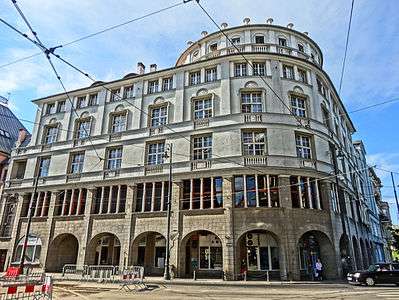 View from Gdanska Street
View from Gdanska Street View from the Square
View from the Square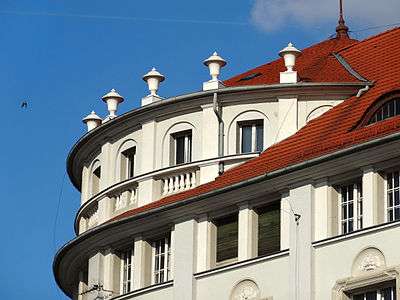 Detail of topping rotunda
Detail of topping rotunda
Foch Street N°2
1901-1902, by Karl Bergner
The house has been built between 1901 and 1902 for Max Zweininger, the owner of a famous hat manufactory in Bromberg,[11][12] living at Elisabethstraße 55, now Śniadecki Street N°4. The building was designed by Bydgoszcz architect Karl Bergner on the site of an earlier building originating from the first half of the 19th century. On the ground floor were established shops, including hats and furs retailers.
In 1940, a ground floor arcade has been added, designed by Jan Kossowski,[13] as he did at the same period on opposite building (Theatre square 6).
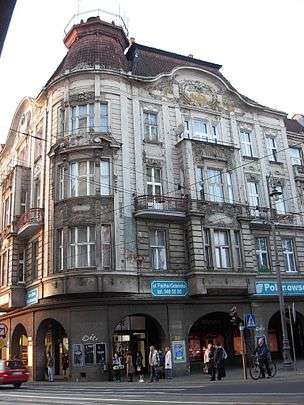 View from Jagellonska street
View from Jagellonska street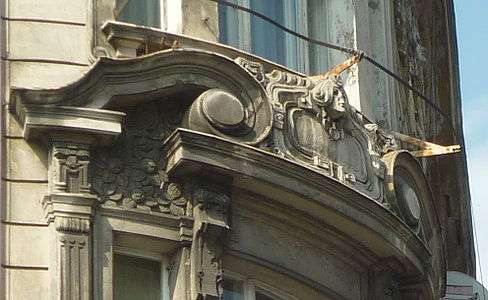 Detail of corner ornament
Detail of corner ornament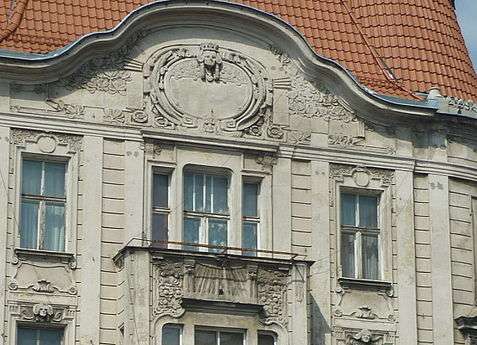 Detail of the gable
Detail of the gable
Foch Street N°4
1901-1902, by Karl Bergner
Registered on the Kuyavian-Pomeranian Voivodeship Heritage list: N°601292, Reg. A/849, April 22, 1996[3]
 View from Theatre Square
View from Theatre Square Detail of gable
Detail of gable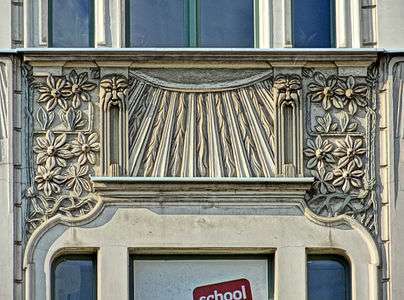 Facade detail
Facade detail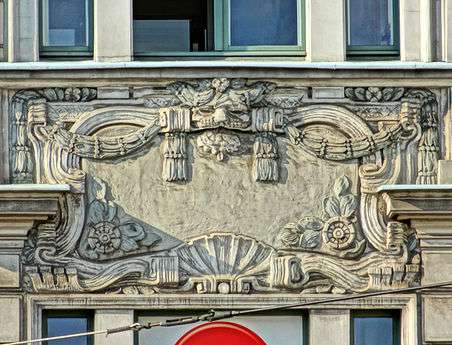 Facade detail
Facade detail Facade detail
Facade detail
Foch Street N°6, 8, 10, 12
Focha N°6, Neoclassical architecture.
Original building from the 2nd half of the 19th century, like the house at Gdanska Street N°40.
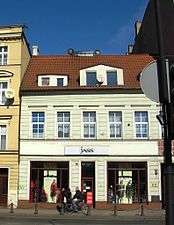 View from Theatre Square
View from Theatre Square
Focha N°8, Neoclassical architecture.
 View from Theatre Square
View from Theatre Square
Focha N°10, Vienna Secession, Eclecticism.
Erected in the 2nd half of the 19th century, the facade is ornamented with many bay windows.
Focha N°12, Eclecticism, Neo-Renaissance.
Erected in the 2nd half of the 19th century, the facade is ornamented with bay windows.
 View from Theatre Square
View from Theatre Square Detail of a bay window
Detail of a bay window Detail of the ornamented gate
Detail of the ornamented gate
Foch Street N°18
1885, by A. Berndt
 View from Theatre Square
View from Theatre Square By night
By night
Foch Street N°20
1884
Building has been renovated in 2007. Since 2015, it has been converted into a four-star hotel with a panoramic terrace on the roof.[14]
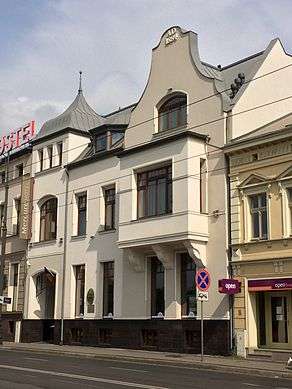 View from Theatre Square
View from Theatre Square
Foch Street N°24
1876, by C. Stamphel
Eclecticism, French and northern European Neo-Renaissance
Architect:
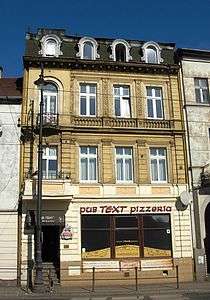 View from Theatre Square
View from Theatre Square
Miscellaneous
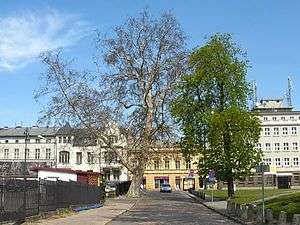
In the western part of the Theatre Square grow specimens of trees and shrubs that are registered as Polish Natural Monuments:
- Four yews,[15]
- A London planetree with a 350 cm circumference trunk.[16]
The 18° East Meridian runs through the Theatre Square.
See also
- Gdańska Street in Bydgoszcz
- Mill Island in Bydgoszcz
- Marshal Ferdinand Foch Street in Bydgoszcz
- Former Municipal Theatre in Bydgoszcz
External links
Bibliography
- (Polish) Czachorowski Antoni red. Atlas historyczny miast polskich. Tom II Kujawy. Zeszyt 1. Bydgoszcz. Toruń: Uniwersytet Mikołaja Kopernika, 1997
- (Polish) Derenda Jerzy. Piękna stara Bydgoszcz – tom I z serii Bydgoszcz miasto na Kujawach. Praca zbiorowa. Towarzystwo Miłośników Miasta Bydgoszczy. Bydgoszcz 2006
- (Polish) Kaja Renata. Bydgoskie pomniki przyrody. Instytut Wydawniczy "Świadectwo". Bydgoszcz 1995
- (Polish) Umiński Janusz: Bydgoszcz. Przewodnik: Bydgoszcz: Regionalny Oddział PTTK "Szlak Brdy", 1996
References
- ↑ Soviet soldiers billeted in the building might have set fire
- ↑ Atlas historyczny miast polskich. Tom II Kujawy. Zeszyt 1. Bydgoszcz: red. Antoni Czachorowski: Toruń: Uniwersytet Mikołaja Kopernika, 1997
- 1 2 Załącznik do uchwały Nr XXXIV/601/13 Sejmiku Województwa Kujawsko-Pomorskiego z dnia 20 maja 2013 r
- ↑ http://www.swiecicki.bydgoszcz.pl/ dostęp 16-09-2010
- ↑ Lewińska, Aleksandra (8 July 2013). "Estetyczna rewolucja w okolicach Mostowej. Będą remonty". bydgoszcz.gazeta. bydgoszcz.gazeta. Retrieved 16 October 2016.
- ↑ MATERIAŁY DO DZIEJOW KULTURY I SZTUKI I BYDGOSZCZY I REGIONU N°5, p.43. ISSN 1427-5465
- ↑ bj (29 September 2015). "Jest moda na modernizm. Oto bydgoskie budynki w tym stylu". bydgoszcz.wyborcza. bydgoszcz.wyborcza. Retrieved 16 October 2016.
- 1 2 "Straßen". Adressbuch nebst allgemeinem Geschäfts-Anzeiger von Bromberg und dessen Vororten auf Grund amtlicher und privater Unterlagen. Bromberg. 1911. p. 169.
- ↑ "Piękne, znane i zaniedbane". bydgoski.pl. Retrieved 19 July 2015.
- ↑ "Savoy - We run the space". savoy.pl. Retrieved 19 July 2015.
- ↑ Marmottes. "Bydgoszcz-Bromberg". bydgoszcz-bromberg.blogspot.com. Retrieved 19 July 2015.
- ↑ "Names". Adressbuch nebst allgemeinem Geschäfts-Anzeiger von Bromberg und dessen Vororten auf das Jahr 1903 auf Grund amtlicher und privater Unterlagen. Bromberg. p. 220.
- ↑ "Bydgoszcz - Kamienica Maxa Zweiningera. Atrakcje turystyczne Bydgoszczy. Ciekawe miejsca Bydgoszczy". polskaniezwykla.pl. Retrieved 19 July 2015.
- ↑ "Nowy czterogwiazdkowy hotel otwarty". express.bydgoski.pl. express.bydgoski. 16 january 2015. Retrieved 16 October 2016. Check date values in:
|date=(help) - ↑ Rozporządzenie nr 36/95 Wojewody Bydgoskiego z 14.02.1995
- ↑ Rozporządzenie nr 11/91 Wojewody Bydgoskiego z 1.07.1991


